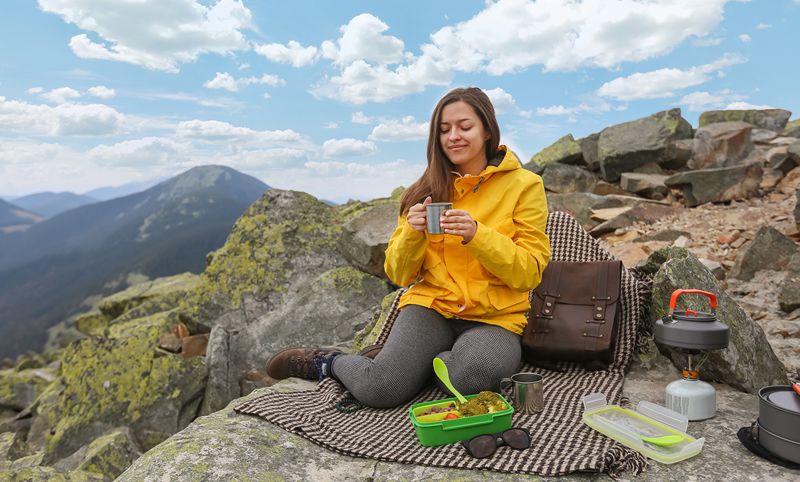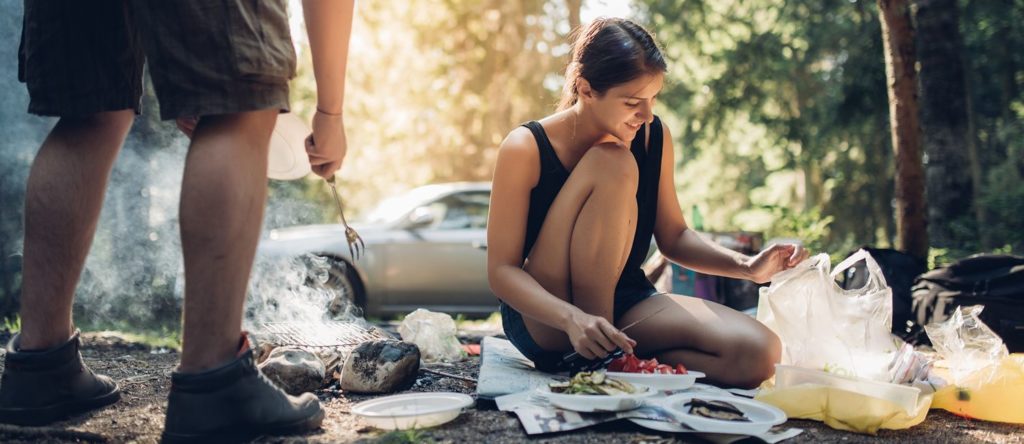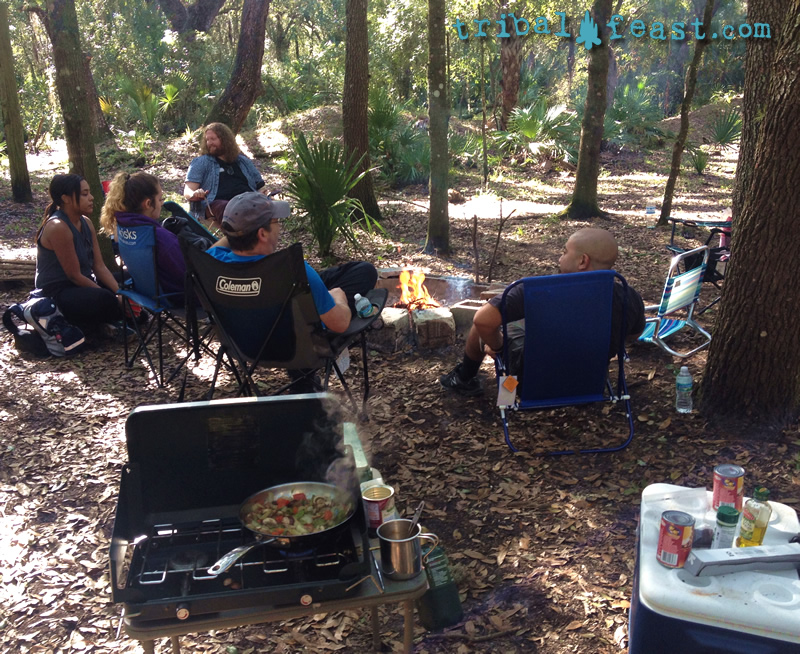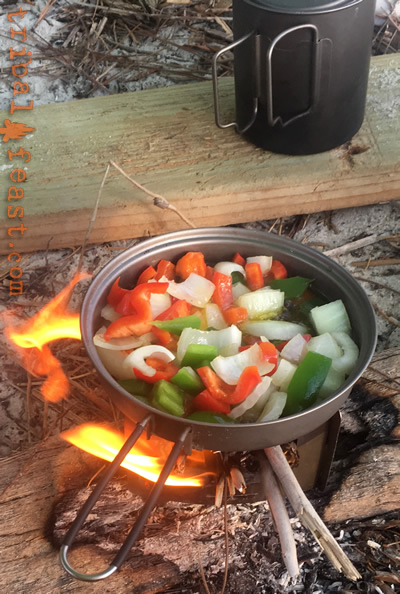Caught in a rut and looking for a fun, new activity to help you or your family get outside more? Maybe you’ve been dying to take up a new hobby but have been a bit tight on either money or time? Or maybe you’ve been trying to find a more engaging way to lose weight and improve your diet?
If any or all of the above apply to you, then adventure picnicking may be the outdoor sport of your dreams.
Over the last few years, adventure picnicking has been growing rapidly in popularity, especially among millenials. As a recreational activity it has a lot going for it: it’s accessible to anyone of any fitness level, it involves cool gear yet is very affordable, it’s healthy, and most importantly, it’s fun!
What is Adventure Picnicking?
Picnicking means different things to different people. Some envision a picnic as a potluck gathering of friends or family. For others, a picnic is a more romantic affair involving wicker baskets, fancy cheeses, wine, and the requisite picnic blanket. What everyone can agree on, however, is that a picnic involves eating in the outdoors.
Adventure picnicking is extreme picnicking where, usually, food is cooked on a lightweight camp stove or campfire. It will generally either take place in a more remote location where traveling light is essential, or involve a menu that will present a challenge to an outdoor chef using cooking gear designed for camping or backpacking.
Adventure Picnicking combines outdoor culinary exploits with exploring and adventure.
The above definition may sound a bit general, but that is one of the intriguing things about adventure picnicking – it is open to interpretation. For some the attraction may be in developing new recipes for their cooking gear and the location and effort getting there is not important. For others, it is all about cooking a meal in an extreme place, so the emphasis would be less on the menu and ingredients and more on the journey.
The manor of conveyance on an adventure picnic is not defined either, making it easy to combine it with other sports like cycling or paddling, and it can also include simply pulling over on the side of the road to cook a quick meal while road tripping. Many touring indie bands are known for their adventure picnicking exploits and have both favorite recipes and cool, off-the-beaten-path locations for impromptu picnics.
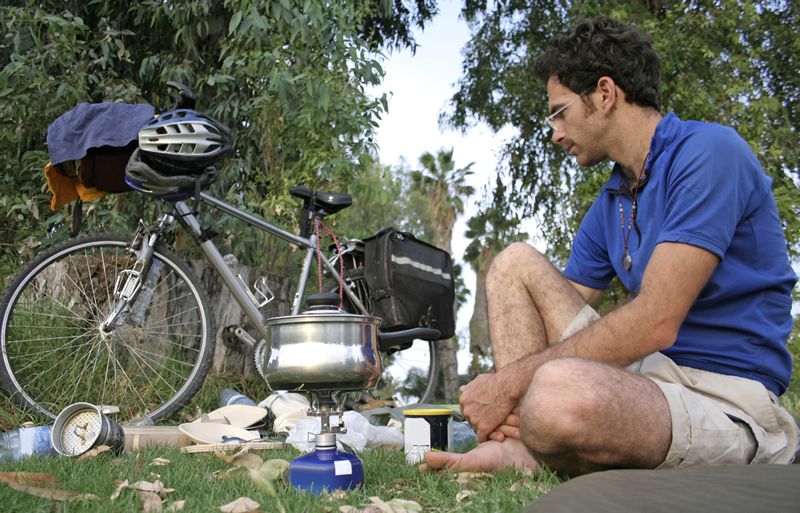
Adventure Picnicking Promotes A Healthy Lifestyle
Whether you are training for The Barkley Marathons or are a chronic couch potato seeking a major lifestyle change, adventure picnicking has much to offer. As mentioned above, YOU define what constitutes adventure and the level of exertion involved in getting to your destination. Whether your destination is the top of a mountain or a picnic pavilion at a local local park, it is still adventure picnicking.
A Phenomenal Approach to Weight Loss
Losing weight is undoubtedly one of the most mentally challenging things a person can face. Goals become hyper-focused on the problem (poor diet and/or not enough exercise), which leads to a seemingly endless rollercoaster of highs and lows.
In adventure picnicking, however, goals revolve around food preparation and getting to a destination. The challenges of “do I feel like exercising today?” and “should I cheat and have that cookie?” become “I wonder if I can make it to that waterfall?” and “should I try that new couscous recipe today?”
Because adventure picnicking puts so much emphasis on meal ingredients and dealing with space, weight, and cooking limitations, it forces you to think a lot about the food you eat and put it in the context of exercise and activity. If you are the aforementioned couch potato, you may suddenly find yourself happily measuring out small portions of dehydrated food into freezer bags as you envision yourself pushing hard on the trail to get to a cool cooking destination you’ve researched.
Also, there are usually no cookies and other temptations available when you are out on your adventure – what you bring with you is all that there is. You may find that you begin to associate reward with a positive and fulfilling experience rather than the fleeting joy of a quick, sugar high.
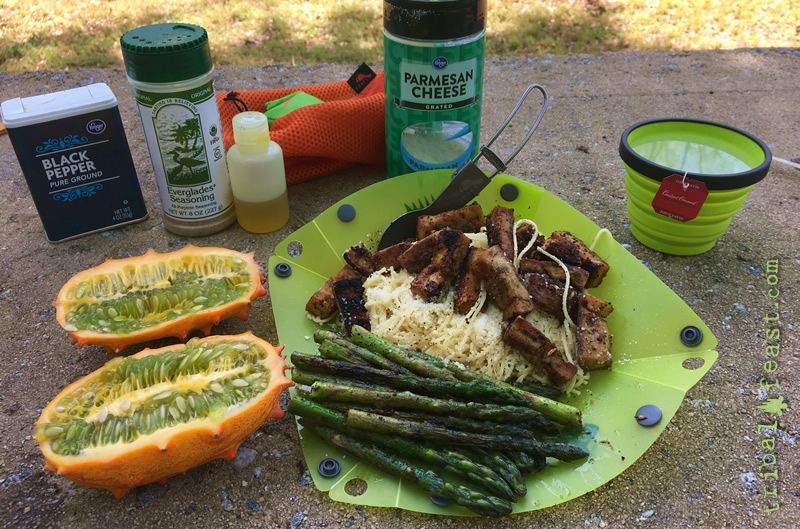
Turn Your Lunch Hour into an Adventure
One of the biggest challenges working people face is having a limited time for lunch. If you find yourself hopping in your car on your lunch hour and swinging through a fast food drive thru, or eating a packed lunch in the break room at your office, adventure picnicking may be healthy change of pace.
Think of it like going on a mini adventure in the middle of your work day. Even if you’re in an urban environment, there is likely a nearby park or interesting public location for you to explore. Just make sure you won’t get into trouble if you fire up your camp stove there. Often, if there is an outdoor grill at a park, it is perfectly legal for you to cook with your stove on the grill, but do a little research first to make sure you are not breaking any laws.
Turn a Family Meal into a Weekly Dinner Expedition
For busy families who struggle to fit exercise into their evenings, adventure picnicking can offer a fun solution. Kids love to explore and do things that are out of the routine, so the idea of a weekly family adventure picnic dinner will usually be met with enthusiasm. Get them involved with both researching the destination and picking the recipes to try and you may find that not only do you finally get that evening walk, but also have extra hands in preparing dinner.
Giving them their own adventure picnicking gear can also help pique their interest and help them further develop a new passion for the outdoors, healthy eating, and a more active lifestyle.
One great advantage for families taking up the sport is the ability to carry a larger selection of fresh ingredients and cooking gear by sharing the load. Outdoor meals can be as elaborate as you want if you have multiple stoves, a wide array of spices, and an abundance of fresh meat and veggies. So put last year’s tattered book bag back in service by filling it with healthy ingredients and some fun, new outdoor gear for your child to try out like a compass for orienteering or his or her very own titanium spork. Once a kid has cooked his or her own veggie omelet in a freezer bag, he or she is usually hooked! Check out our freezer bag omelet recipe here.
Recipes for Adventure
If you have absolutely no experience with cooking at home, much less on a tiny backpacking stove, fear not. There is an endless variety of camping and backpacking recipes available on the web for free. Even if you are a vegetarian, vegan, or have a special dietary need, you will have no problem googling up some exciting and tasty recipes to try.
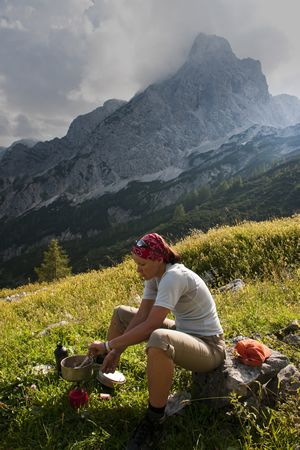
A lot of people who feel less inclined to cook at home, develop a passion for it on the trail, and this usually has to do with the fun of playing with the cool camping gear, like liquid fuel stoves and titanium cookware. This enthusiasm inevitably spills over into recipe research and meal planning, so even if you start out by packing sandwiches and other ready-to-eat foods, go ahead and at least get what you need to make hot tea or coffee. Once you are comfortable with that, move on to dehydrated meals, then, finally, try cooking a more elaborate recipe with fresh ingredients.
If you are an adventure picnicking newbie, check back with us often and don’t forget to follow us on social media. We’ll continue to post new outdoor recipes and cooking tips here on Tribal Feast, as well as giving you some great tips on cool destinations and awesome gear.
Explore Your World
In our screen-oriented society, it is easy to forget the beauty and wonder that lies right outside our front doors. No matter where you live, there is most likely a park or place of interest close by that is worth exploring. Getting out of the house with the goal to explore will give you the chance to be a kid again and you will probably be surprised at the cool local things to see a do that a little research may turn up.
Adventure picnicking can also encourage you to venture out a bit farther for weekend trips to new locations. Whether you are camping or on a day trip, being in new surroundings is always good for the soul. And speaking of camping, if you have been “camping curious” but were afraid to try it, adventure picnicking is a great way to get your feet wet in the outdoors.
A Sport For The City
Urban exploring has become a big thing in recent years. Places like derelict buildings, abandoned factories, and subterranean passageways are prime targets for many self-proclaimed urban explorers, but if risking danger and illegal trespassing is not your thing (and we encourage it not to be), there are plenty of safe, legal, and cool things to see in any city. Museums, nature parks, and historic districts are great places to start, but many cities have lesser publicized art and indie music scenes, greenways, and graffiti districts that are really worth checking out. Usually these can be found in revitalized industrial zones full of vacant lots, so asking a few locals will usually provide you a cool spot where you can safely and legally fire up your camp stove.

Regardless of where you live and how hectic your lifestyle is, you may find that adventure picnicking is a great way to sneak some fresh air and fitness into your busy schedule. Even if you can’t climb a mountain or walk down a beach, you can still grab your picnicking gear and make a quick lunch alfresco, cook a fancy dinner for your significant other in the park, or even make a meal while taking the dog out for an evening walk. It’s your picnic and your adventure.
Sharing The Fun
Lastly, one of the great things about adventure picnicking is that it can be as social as you want it. You can forge ahead quietly into the wilderness by yourself or you can go with thirty people and have a remote outdoor dinner party. It can be a romantic meal for two overlooking a mountaintop vista or it can be a blowout beach party on a remote shoreline away from tourists. Adventure picnicking can be a solo sport or social gathering.
For those with a more social outlook, there is much to share with your fellow picnickers. There are recipes and cooking tips to swap, favorite locations to reveal, and always new pieces of gear to show off. For Instagramers, there are an endless variety of things to photograph and share including beautiful vistas, wildlife, the meals that have been cooked, and of course the odd selfie or two.
A Primer on Adventure Picnicking Gear
Anyone who has dabbled in sports like cycling, skiing, or kayaking knows that outdoor sports can cost a small fortune. Many people who are very interested in these sports never try them because either they lack the finances to get started or don’t have the space to store the equipment. Fortunately, adventure picnicking gear is not only super cheap, but also very compact. Many adventure picnickers will keep their gear in their car or by their front door so that it is always handy for an impromptu mini expedition.
Camp Stoves, Fireboxes, Grills, and Grates
The first consideration is how you plan to cook your food. The most common way is with either a propane canister or liquid fuel backpacking stove. Depending on the stove model, this approach offers the most versatility and control over the cooking flame. Backpacking stoves can range in price from $200 for an expedition quality stove to under $10 for a decent canister fuel model. One of the most popular adventure picnicking stoves, the BRS-3000t Titanium Stove (read our review here), can commonly be found for under $20, yet is very high quality and one of the lightest on the market.
Other types of camp stoves run on alcohol, Sterno, or Esbit tablets, and can often cost less than the aforementioned canister stoves. A functioning alcohol stove can even be made out of an aluminum can, but keep in mind if you want to do more than heat water, a decent stove will make a huge difference.
One interesting take on the camp stove that is worth mentioning is the firebox. These stoves are typically thin sheets of steel that assemble into a small box. Small twigs and sticks are burned in the box, and because of the efficiency of this setup, it offers a small, somewhat controllable fire that can actually be very good for cooking. The advantage here can be light weight since a collapsed firebox weighs very little and you don’t have to carry fuel. The disadvantage is that this type of stove may be prohibited for use in many locations. Do your research before heading out.
If you do choose a firebox stove, we highly recommend the Bushbox Ultralight Outdoor Pocket Stove (here is our in depth review). This is the ultra in minimalism and light weight and ours has held up great!
Cooking over an open fire may also be an option in some places and for this approach you will need some sort of grill or cooking grate. There are many ultralight backpacking grill options out there, like this titanium grill on Amazon, but even a small grate from a home cooking appliance can work if your budget is tight. As mentioned above, always make sure your approach to cooking is legal at your destination before heading out.
Cookware for Adventure Picnicking
Cookware can be one of the most exasperating and limiting parts of your mini outdoor kitchen and it’s worth spending a little extra money here up front and then upgrading your other gear later. If you’ve ever tried to cook a fried egg on a tiny backpacking frying pan, you know the struggle. And while these challenges are part of the fun of adventure picnicking, having good quality cookware that is lightweight, functional, and easy to clean, makes the entire experience that much more enjoyable.
Pots and pans that are usable for adventure picnicking can be made of a variety of materials including cast iron, carbon steel, stainless steel, aluminum, and titanium. If you are cooking over a fire, cast iron, carbon steel, or stainless steel is the best choice, but keep in mind that cast iron and carbon steel can be very heavy and not something you are going to want to pack in on foot. Stainless, if light enough, can be a good choice and offers a great cooking surface that can be non stick if seasoned correctly.
Aluminum can be very lightweight and very affordable, but avoid pans with non stick coatings as they can become unsafe when they get scratched – and they will get scratched while out on adventures.
Lastly, titanium offers the lightest option and more and more backpackers and adventure picnickers are making the switch, especially since the price of titanium cookware has come down substantially in recent years. Because titanium is so thin, you’ll find it easy to burn food if you are not paying attention, but fortunately, it is also nearly indestructible and very easy to scrub clean. To learn more about titanium cookware, read our break down of our favorite selection of Titanium Cookware here.
Carrying Your Gear
The size of the backpack you need starts with your gear choices above, other cooking paraphernalia you bring, and whatever meal ingredients you choose. If you will only be using an ultralight firebox stove and small 750 ml pot with dehydrated meals, even a Camelbak Mule or a large fanny pack would suffice. For lightweight cooking with a smaller canister stove, a typical day pack like the Osprey Daylite Plus offers plenty of room.
If Ultralight Adventure Picnicking interests you, don’t miss our in depth guide!
For a more full-sized cooking kit and larger amounts of fresh ingredients, a larger backpack may be a better choice, especially if you need a lot of room for items like a jacket, camera, first aid kit, or a battery to charge your phone. Luxury items like a camp chairs and blankets also take up a lot of space, so keep that in mind as well when selecting your first pack.
Getting Started
The TL;DR is that adventure picnicking is an easily accessible, healthy, and fun outdoor sport that can be geared for solo adventurers, families, and large social groups. It can be a great catalyst for weight loss and other lifestyle changes, and can be easily incorporated into busy lifestyles.
The best thing about adventure picnicking, however, is that it costs very little for you to get started. Look in your closet, under the bed, or in the basement. Do you have a backpack, a camp stove, and a small pot? If so, you are all set!
Well, what are you waiting for?
